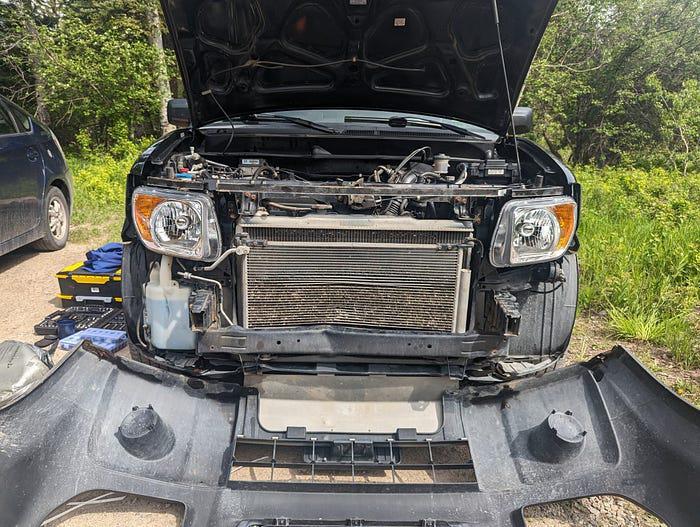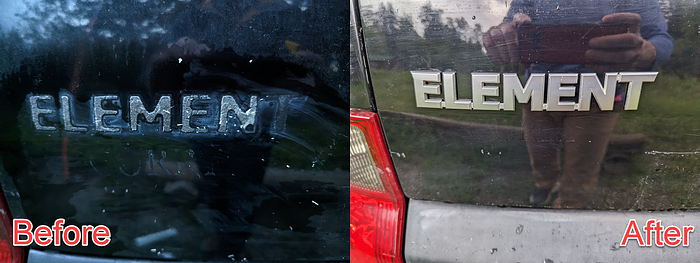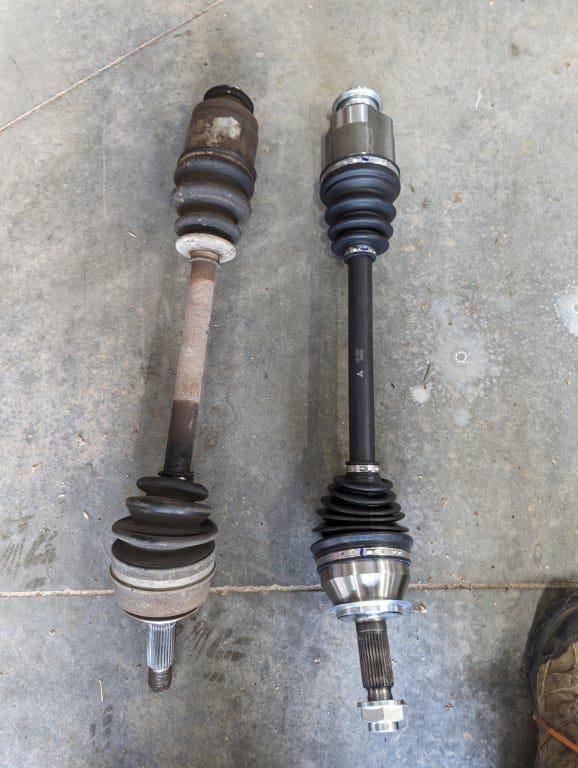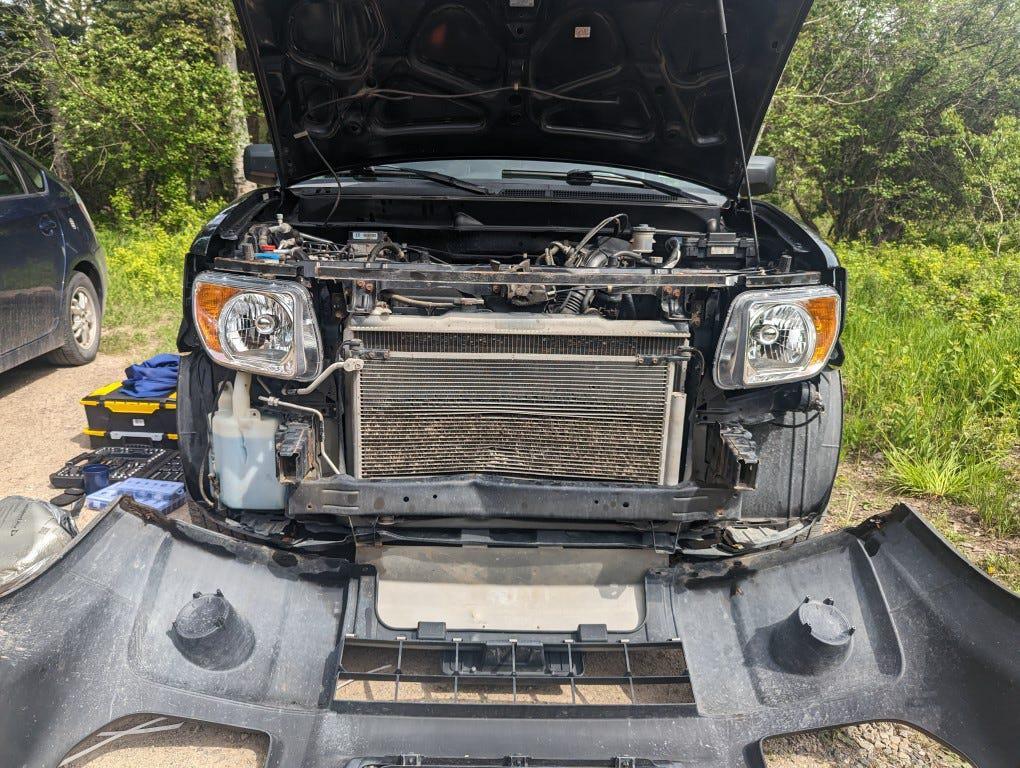A few months ago, I decided to commit to my car.
You see, I had the same car for the past 18 years. I bought it new. I was the sole owner. And I had been very satisfied with it for many years, but recently I had some dissatisfaction.
During a recent visit from my parents, I drove hundreds of miles in this vehicle and became self-conscious about its shortcomings.
No longer attached center console. A disconcerting lump reverberating from the front end as I made turns. Foggy headlights. Cracked front windshield. A creaking exhaust system literally attached to the bottom of the car with hose clamps.
My parents, being the champions they are, took all of this in stride. But the topic came up: "So, have you thought about getting a new car?"
I thought about this for the next few days, but ultimately settled on a position. "No, I don't really have a car in mind that I want to purchase yet. I am quite content with what I have."
As I stood on the hill, I looked at the landscape: If I like this car and plan to keep it for another 5 years, what actions should I take? What do I want to fix?

I started small.
I had kept this car reasonably clean over the years, but I had never wiped down the rags under the hood. I had always been afraid that washing something in the engine bay would cause some kind of permanent damage. However, after a 5-minute search, I found a YouTube video that walked me through the process.
Next was the foggy headlights. I considered trying some kind of headlight restoration kit, but ultimately decided to replace them entirely. I had never worked on the front end of a car before, but I found a YouTube tutorial that showed me what parts I needed and what to do.
Encouraged, I continued. The driver's seat had developed an annoying rattle over the past year. Thankfully, a quick search on YouTube led me to this video. In this video, it was revealed that the issue was likely loose bolts. I followed the instructions and the rattle was gone 30 minutes later.
Having replaced the tailpipe and exhaust flange 2 years ago, I also knew I needed to replace the rusty muffler and silencer. I found a YouTube tutorial that showed me how to do this.

What else can I fix? The car badges had fallen off the back tailgate. From YouTube, I learned how to remove the remaining adhesive, clean the area, and reattach.

I had the same set of summer tires on the car for over 10 years, but how can I tell if they need to be replaced? I asked YouTube and learned about the quarter test and penny test. My tires failed both, so I went ahead and bought new ones.
The tire shop that installed them kindly informed me that new rear brake pads and rotors were needed, as well as a new front CV axle. They quoted me around $900 for the job. I declined and went back to YouTube school. A mechanic friend replaced the axle while I replaced the rear brakes: $175 in parts.

The brake work became a kind of epic.
I discovered that one of the caliper slide pins on one side had seized (only after I over-illuminated and broke one of them). I also managed to damage the emergency brake on the same side. Fun fact: Do not attempt to remove the rear brake rotor without removing the emergency brake. Again, thanks to YouTube, I was able to repair the electronic brake, install a new caliper bracket and slide pin. I also flushed the brake fluid while I was at it.
Of course, there is still more to do. I found out about the low ball joint that needs replacing and the front brake inspection (of course, learned from YouTube) revealed another seized caliper slide pin. One joy of owning an old car is that there is always something that can be replaced or upgraded.
However, after doing all this work over the past year (in addition to regular fluid and filter changes), I have learned a lot from using YouTube more appropriately, from a beginner who can now at least write words about how to go about repairing their car. I understand what a "caliper slide pin" does.
If you find yourself in the same boat I was in a year ago and want to become more proficient at repairing your car using YouTube, I have some advice.
Start with Routine Service Items
If you want to start working on your car, it's best to start with maintenance intended to be done on a regular schedule. Generally, this includes tightening bolts, clips, and drain plugs.
- Designed to be serviced regularly.
- Actually being taken apart regularly.
Loosening an oil drain plug that was tightened 6 months ago is far easier, and more forgiving, than dealing with a (literally!) rusted axle nut torqued to 150 pound-feet for 10 years. Getting accustomed to basics like fluid changes and filter changes gave me the confidence to move on to actual repairs.
If you are starting from absolutely zero car service experience, one of the easiest jobs on many vehicles is to replace the cabin air filter. In my car, this job took all of 5 minutes and can be done without any tools. Of course, your mileage may (literally!) vary. And of course, so does your own homework. Speaking of which...
Channel Selection
YouTube is a great resource for DIY car repairs. You already knew that. However, there are some tactics you can use to really maximize this library of automotive maintenance Alexandria.
It can be helpful to find YouTube channels that specialize in repairing specific vehicles. While it's not difficult to assemble a playlist of repair videos from all of YouTube, it's much easier to start with one or two reliable sources that are deeply knowledgeable about the vehicle. For me, those sources were 1A Auto and Eric The Car Guy.
Before doing the work yourself, you should aim to watch at least 2 different videos. Not all YouTubers include details like the tools needed, socket sizes, torque specs lists, etc. (1A Auto excels at this).
Similarly, I like to look for two different types of videos that show the same job. I always try to find one from an expert working in a shop.
...and another from an amateur working in their driveway:
...And another by amateurs working on their private roads:
Generally, shop videos are brighter and in a higher state of production value, making it clearer to understand what is happening. They also tend to use cameras mounted on tripods, reducing the likelihood of inducing motion sickness. Some private road mechanic YouTubers needed one thing for the Paul Green Grass Film School's "Dominance of Bone".
However, I still like private road videos. Because they give a better approximation of how difficult the work is without a lift using hand tools. One of my favorite car repair channels, Chrisfix, emphasizes doing all work under these conditions, even for difficult repairs such as hybrid battery replacement and complete front suspension rebuild.
Don't forget that YouTube moderators flagging videos on cars. Some videos may be completely wrong.
Please explain how to bleed the brakes in the correct order confidently for one brake fluid flush that explains how to bleed the brakes in the wrong order for this specific vehicle.
Fortunately, by scanning comments, you can find such inaccuracies. The most voiced comments on the aforementioned brake video called out errors.

Finally, while YouTube is a great resource for maintaining and learning to repair vehicles yourself, remember that it is not the only resource. The entire internet is full of people who may have similar challenges and cannot wait to post them on Reddit or vehicle-specific message boards like you.
Final Thoughts
I do not intend to sign off pretending that all readers should go out in the future. It doesn't even explain me.
After spending quite a few weekends under my car this year, I am beginning to narrow down what my "hustle return" threshold is. That is, the type of repairs
- Within my skill level
- Actually enjoyable to do
- Seem worth the effort
For example, because I fail the first two criteria, I will probably pay the shop to do that ball joint replacement. I have now learned how painful it is to tear apart rusted suspension components. Yeah, I don't want to do that.
"I just don't want to do it" is a perfectly acceptable reason to outsource a task to a professional. Before deciding to call in a pro, I think it's worth investigating how difficult the repair is at least to research. YouTube schools can teach you how to do these repairs, but can also help you make a decision.
